- Analyzers
- Optics & Sources
- Technologies
- Support
- About
Get Fast D4294 Sulfur Results Without Centrifuging
Abstract
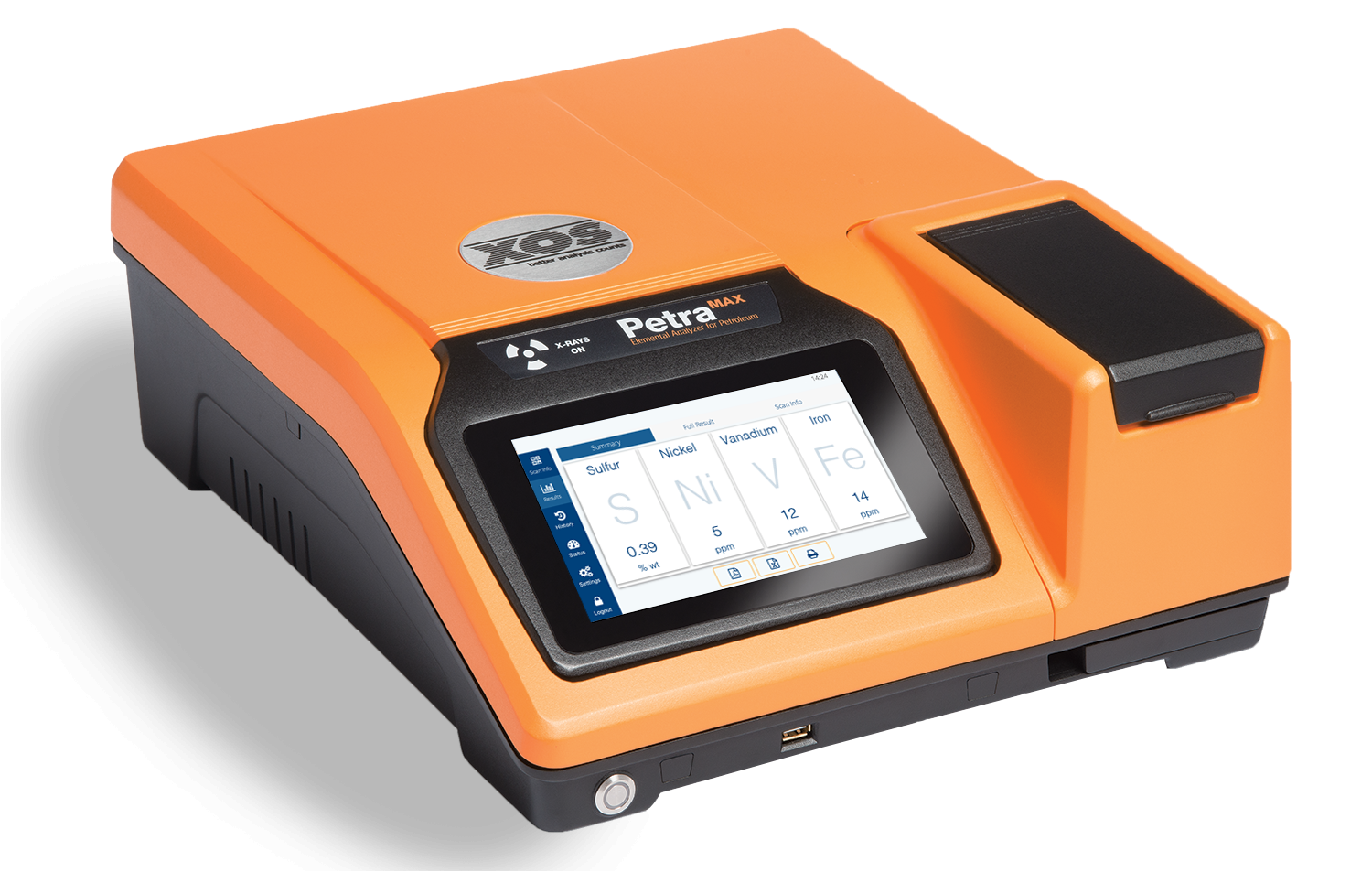
Petra MAX delivers advanced D4294 sulfur analysis in addition to 12 elements from P to Zn including Ni, V, and Fe. This robust benchtop analyzer complies with ASTM D4294 and ISO 8754 for measuring sulfur in hydrocarbons. Petra MAX is powered by HDXRF, utilizing XOS patented doubly curved crystal optics coupled with a high-performance silicon drift detector and an intense monochromatic excitation beam. This industry-leading technology reduces background noise and increases signal-to-noise output, enabling low detection limits and high precision without the need for consumable helium gas, a vacuum pump, or extensive sample preparation.
Background
Petroleum professionals looking to certify their products are commonly tied to specific method types for analysis. Two known methods, ASTM D4294 and ISO 8754, utilize a measurement technique known as X-ray Fluorescence, or XRF. Many methods come with their own unique set of interferences and bias corrections. For XRF, a common matrix effect interference involves particulates settling to the bottom of the sample cup and absorbing the X-ray signal. This matrix effect will ultimately influence the total sulfur measurement and lead to a biased result. Refineries and third-party certification companies using XRF for high- particulate samples have relied on centrifuging samples to ensure an accurate sulfur measurement – which involves a time-consuming sample preparation process.
XOS conducted an application study titled A New Solution to Eliminate Centrifuge for Sulfur in Crude Oil Analysis. In this study, we analyzed low, medium, and high particulate level crude oils using both a Petra MAX analyzer and a traditional XRF analyzer. Petra MAX is a multi-element D4294 analyzer designed with a vertical sample introduction system to help eliminate biased results due to particulate settling. The conclusion of this paper was that the Petra MAX introduction technique eliminates this matrix effect altogether and offers a more efficient process compared to centrifuge pretreatment.
Check out this application study by visiting www.xos.com/eliminate-centrifuge
In the following application study, we will assess the ability of Petra MAX™ to eliminate the need to centrifuge by running a real-world crude oil sample supplied by a large pipeline. In this paper we will run these samples both with and without centrifuge pretreatment. We will also run the same samples using a traditional XRF analyzer setup, with and without centrifuge pretreatment, and compare the results.
Experiment
The sample used for this experiment contained an iron concentration of 28 ppm. Samples were prepared by pipetting roughly 8mL of sample into a standard XRF cup after it was dusted off with canned air. Then the cup was sealed using a sheet of Etnom® film which was also dusted off with canned air. Prepped samples were then placed in their respective XRF analyzers and measured for 100 seconds for 3 repeats. We ran each sample 3 times to demonstrate the effects of particulate settling over the duration of the three measurements.
Each sample type was centrifuged prior to preparation of a new sample at a relative centrifugal force (RCF) of 600 for 60 seconds. After, samples were measured for 100 seconds for 3 repeats with both analyzers.
Note: No significant difference was seen in vented versus non-vented samples, as is common with this type of application.
Results
Understanding the Data
The data gathered from the experiments was compiled into several different graphs that showcase various findings. Each graph will be shown and explained with additional data sets. First, we will explore the effects of iron settling in a sample by showing non-centrifuged results on a traditional XRF system. Then we will incorporate data from traditional XRF techniques after centrifuging. Lastly, we will bring in data run on a Petra MAX.
A complete, comprehensive graph (Graph 4) can be found at the end of this segment.
Graph 1
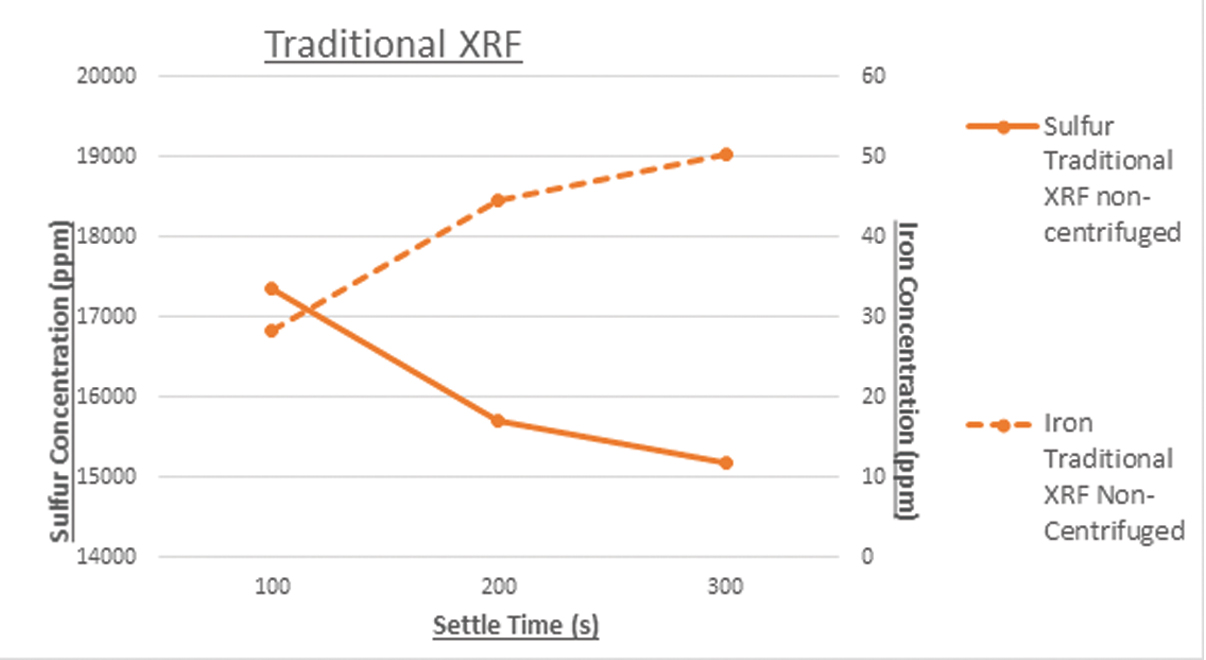
The Effects of Settling with Traditional XRF
The data shown in Graph 1 indicates that there is a direct relationship between the iron concentration, marked by the dotted line, and sulfur concentration when using traditional XRF, marked by the solid orange line as the sample settles over time. The takeaways from this data are:
-
As iron settles in the sample cup, sulfur concentration goes down.
-
This bias may lead to underreported sulfur.
-
Iron settles at different rates.
-
With traditional XRF, it is difficult to account for this iron settling without specific sample preparation.
Graph 2
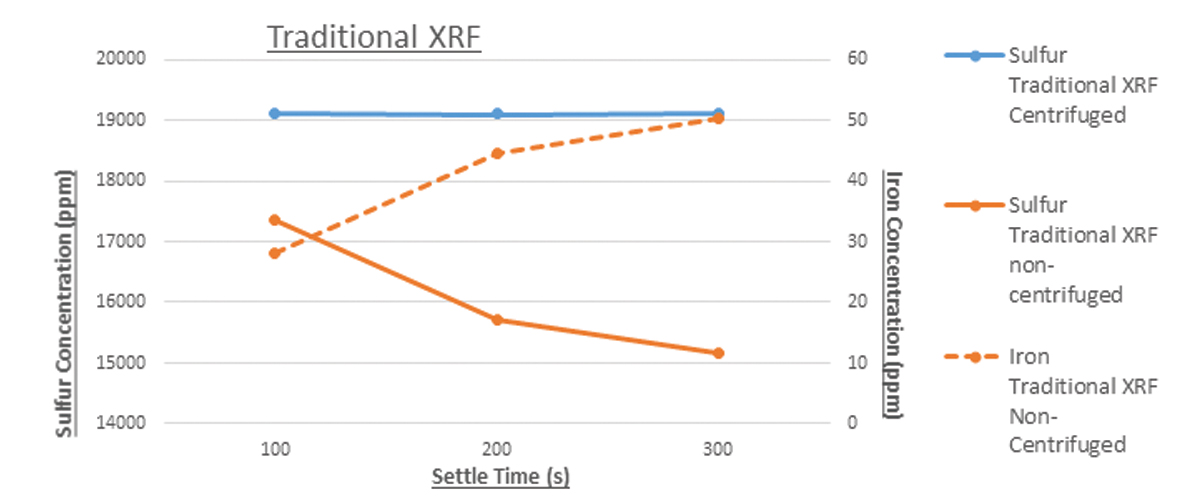
Mitigating Bias by Centrifuging with Traditional XRF
We concluded from our first graph that accounting for this bias without conducting additional sample preparation is difficult in traditional XRF analysis. When using traditional XRF, this is done by centrifuging the sample, which adds preparation. In Graph 2 we have added in sulfur data for the same sample after centrifuging on a traditional XRF analyzer. The following can be observed:
-
The sulfur concentration has mostly stabilized at a higher concentration than the non- centrifuged sample.
-
Removal of particulate matter by centrifuging (including iron) mitigates the bias issue.
Graph 3
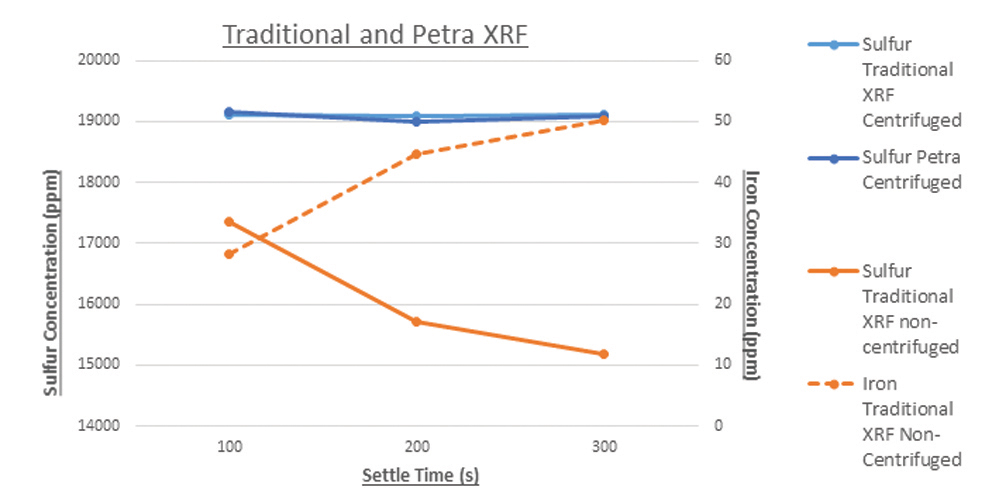
Removing the Need for Centrifuging with Petra MAX
As we have observed, centrifuging is necessary when using a traditional XRF system. What might the data look like when using a Petra MAX analyzer and its vertical sample introduction method? First, we will showcase Petra MAX data on a centrifuged sample in Graph 3, which acts as a study control to show that the centrifuged sample data is comparable whether run on Petra or a traditional XRF system.
Graph 4
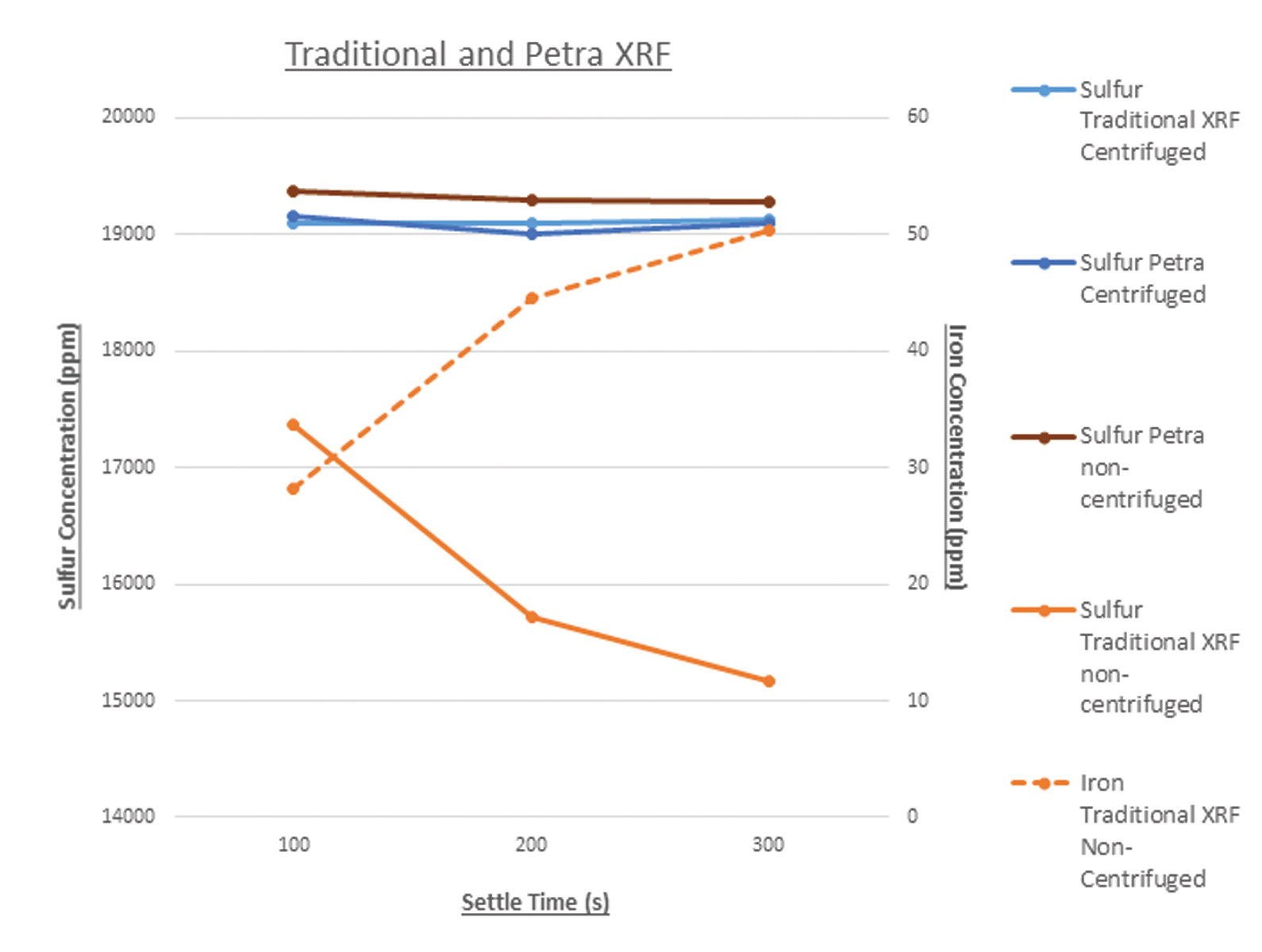
Lastly, to showcase how Petra MAX can eliminate the need for centrifuging, we will display all the data together in Graph 4. This combined data brings in results from measurements of the same crude oil sample run on a Petra MAX without centrifuging. The Petra non-centrifuged data shows increased measurement stability over the traditional XRF data (both centrifuged and non-centrifuged) and a slightly higher bias over the centrifuged data (both traditional and Petra XRF).
The increased measurement stability on the non- centrifuged Petra sample vs. traditional XRF is due to Petra’s vertical sample introduction system. This orientation mitigates the matrix effects from settling that may occur over the 300s settling time. Particulate matter settles to the bottom of the vertically-oriented sample cup and away from the focal point of analysis, making for a more stable measurement over time. The slightly higher bias of the Petra non-centrifuged data vs. the centrifuged data is likely due to sample repeatability. The average of the three Petra centrifuged samples is 1.909% and the average of the three non-centrifuged samples is 1.931%. The difference between these samples is 0.022, which is within repeatability at this concentration (r=0.025).
Conclusion
Settling can occur quickly and as a result, even highly efficient technicians can run into matrix interferences when using D4294 or ISO 8754 methodology. These interferences can become quite costly as they can lead to misclassification of crudes as sweet or sour. With the introduction of Petra MAX, professionals can now run crude samples with a higher degree of measurement stability over time and avoid the hassle of centrifuging samples before measurement.
Author: Joseph Iaia, Petroleum Product Manager

